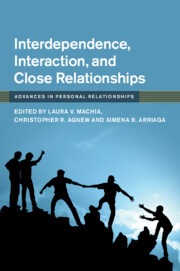Book contents
- Interdependence, Interaction, and Close Relationships
- Advances in Personal Relationships
- Interdependence, Interaction, and Close Relationships
- Copyright page
- Contents
- Figures
- Tables
- Contributors
- Acknowledgments
- Introduction
- Part I Interdependence, Situations, and Context
- 1 Situations in Close Relationships
- 2 The Structure of Interdependence Shapes Social Cognition in Relationships
- 3 Home Is Where the Heart Is
- 4 Ethnicity, Interdependence, and the Investment Model of Commitment Processes
- Part II Interdependence, Security, and Risk
- Part III Interdependence, Goal Pursuit, and Person Factors
- Part IV Interdependence, Timing, and Expectations
- Index
- References
1 - Situations in Close Relationships
from Part I - Interdependence, Situations, and Context
Published online by Cambridge University Press: 19 June 2020
- Interdependence, Interaction, and Close Relationships
- Advances in Personal Relationships
- Interdependence, Interaction, and Close Relationships
- Copyright page
- Contents
- Figures
- Tables
- Contributors
- Acknowledgments
- Introduction
- Part I Interdependence, Situations, and Context
- 1 Situations in Close Relationships
- 2 The Structure of Interdependence Shapes Social Cognition in Relationships
- 3 Home Is Where the Heart Is
- 4 Ethnicity, Interdependence, and the Investment Model of Commitment Processes
- Part II Interdependence, Security, and Risk
- Part III Interdependence, Goal Pursuit, and Person Factors
- Part IV Interdependence, Timing, and Expectations
- Index
- References
Summary
A science of close relationships stands to benefit from an understanding of the situations in which interactions between partners take place. In this chapter, we briefly review recent advances in situation research. Within the current decade, several new taxonomies have been put forward that describe how people perceive situations. Functional Interdependence Theory, in particular, posits that people are well-prepared to understand situations in terms of interdependence. New instruments based on Functional Interdependence Theory and other taxonomies for the first time allow researchers to measure in a comprehensive way how people subjectively perceive situations. Coupled with experience sampling methods, which allow the collection of psychological measures in everyday life, these instruments enable researchers to paint a full picture of the interdependent situations people experience in their relationships. We discuss how studying the situations partners experience together in daily life allows researchers to find new answers to questions arising from a) Interdependence Theory, b) Attachment Theory, and c) theorizing on relationship maintenance behaviors. Finally, we offer a framework for research on situational interdependence in close relationships.
- Type
- Chapter
- Information
- Interdependence, Interaction, and Close Relationships , pp. 11 - 36Publisher: Cambridge University PressPrint publication year: 2020
References
- 3
- Cited by

